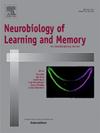Are the principles of Pavlovian conditioning in insects conserved with those in mammals?
IF 1.8
4区 心理学
Q3 BEHAVIORAL SCIENCES
引用次数: 0
Abstract
Pavlovian conditioning, in which a relatively insignificant stimulus (the conditioned stimulus, CS) is paired with a biologically significant stimulus (the unconditioned stimulus, US), is a ubiquitous form of associative learning found in many animal phyla. Modern theories in mammals suggest that the prediction error, i.e., the discrepancy between the predicted unconditioned stimulus (US) and the actual US, drives conditioning, and that the conditioned response (CR) to the conditioned stimulus (CS) is flexibly guided by the expectation of the US. These theories were proposed to overcome limitations of conventional theories, which assume that contingency or correlation between the CS and US is sufficient to account for the achievement of conditioning and that the strength of the CS-US association is enough to determine the magnitude of the CR. It remained unclear, however, whether the modern theories account for Pavlovian conditioning in invertebrates. Here, I address this issue by reviewing recent studies in insects. It has been demonstrated that the error correction learning rule achieves the conditioning in crickets, and the production of the CR is guided by the current value of the US in fruit flies, crickets, and honey bees. From these findings, I conclude that the principles of Pavlovian conditioning in insects are, in essence, conserved with those in mammals. A crucial question to be addressed is how sophisticated forms of Pavlovian conditioning, comparable to those achieved in large-scale neural networks in mammalian brains, are accomplished by small-scale neural networks in insects.
昆虫的巴甫洛夫条件反射原理是否与哺乳动物相同?
巴甫洛夫条件反射是指一个相对不重要的刺激(条件刺激,CS)与一个具有生物学意义的刺激(非条件刺激,US)配对,是在许多动物门中发现的一种普遍存在的联想学习形式。现代哺乳动物理论认为,预测误差,即预测的非条件刺激(US)与实际的US之间的差异,驱动条件反射,对条件刺激(CS)的条件反应(CR)是由US的预期灵活引导的。这些理论的提出是为了克服传统理论的局限性,传统理论假设CS和US之间的偶然性或相关性足以解释条件反射的实现,CS-US关联的强度足以决定CR的大小。然而,现代理论是否解释了无脊椎动物的巴甫洛夫条件反射尚不清楚。在这里,我通过回顾最近对昆虫的研究来解决这个问题。已经证明,在蟋蟀中,纠错学习规则实现了条件反射,在果蝇、蟋蟀和蜜蜂中,CR的产生是由US的当前值引导的。根据这些发现,我得出结论,昆虫的巴甫洛夫条件反射原理本质上与哺乳动物一样保守。需要解决的一个关键问题是,与哺乳动物大脑中的大规模神经网络所实现的类似的复杂形式的巴甫洛夫条件反射是如何由昆虫中的小规模神经网络完成的。
本文章由计算机程序翻译,如有差异,请以英文原文为准。
求助全文
约1分钟内获得全文
求助全文
来源期刊
CiteScore
5.10
自引率
7.40%
发文量
77
审稿时长
12.6 weeks
期刊介绍:
Neurobiology of Learning and Memory publishes articles examining the neurobiological mechanisms underlying learning and memory at all levels of analysis ranging from molecular biology to synaptic and neural plasticity and behavior. We are especially interested in manuscripts that examine the neural circuits and molecular mechanisms underlying learning, memory and plasticity in both experimental animals and human subjects.

 求助内容:
求助内容: 应助结果提醒方式:
应助结果提醒方式:


